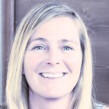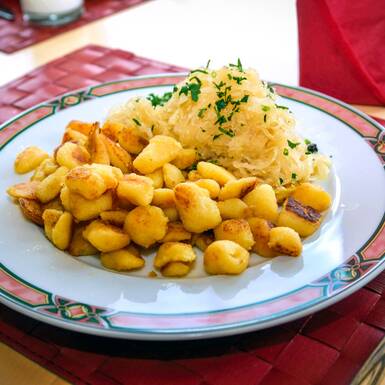- Traditions
Wooly summer guests
Around 500 four-legged landscape gardeners do their work during the summer months on the Schattberg. Nineteen farmers from the region bring their sheep to the Home of Lässig in the early summer. The grazing summer guests ensure that the grass on the steeper areas is kept short and provide for wood-free Alpine pastures. The diligent guardian of the woolly four-legged animals is Gottfried Manzl, who tends to his protégés daily.
“Working as a liftie, I am up on the mountain anyway and always keep a check on the sheep”, Gottfried reveals as we ride the SchattbergXpress gondola to the top station. And with „liftie" he means, tha he is working for the lift company. Already on our ascent, he looks peers out and starts to count the sheep. The picturesque summer residence of the sheep stretches from the Schattberg middle station to the Westgipfel. Through the binoculars, Gottfried has already discovered a third of the herd as we approach the top station. “The rest” he comments “I’ll visit during my lunch break and in the evening. If a sheep is missing, I’ll search for it on my motorbike”.
In harmonious coexistence with hikers, mountain runners and free riders, the sheep of various breeds enjoy peace up here at an altitude of 2,000 m and graze on fresh grass. Gottfried has his own sheep up here and explains “My heard consists of 50 Coburg Fox Sheep – a resilient and undemanding domestic breed of sheep. Of course, I can easily identify my sheep from the others, and they know me, just like the other 450 sheep on the mountain. When they hear or see me, they all come immediately to me”. Gottfried then fills a bucket full of salt and heads towards the summit pastures around Schattberg to prove it. “Here there is enough grass for all – only after the last winter where there were heavy snowfalls, did it take a little longer for the sheep to be brought up to the pastures. Nevertheless, the sheep receive salt and minerals from me every day when I can also take the chance to have a close look at them and make sure they are all awake and healthy”.
Growth and loss
With a loud baa, the small little woolly clouds set themselves in motion and hurry towards Gottfried, who is standing on the pasture with his bucket. Numerous bikers and hikers pause and watch the sheep taking the salt. Snow-white domestic sheep, alpine stone sheep and South African Dorpers and black-nose sheep all gather around Gottfried and curiously push their noses into the bucket. Gottfried scratches them behind the ears, pats the on the back when he observes a small lamb laughs happily “We have a new addition again! Lambs are born here time and time again during the Alpine summer and accompany us back down to the valley in the autumn. Unfortunately, however, there are also losses as in an exposed location, it is often not a safe environment for the sheep. Thunderstorms and a lightning strike sometimes take the life of sheep. When the weather takes a turn for the worse, we have to bring the sheep safely back down the valley so they don’t get snowed in up on the mountain. My son Christoph and his wife Carina assist me with caring for the sheep. Our four-legged guests are well cared for during the summer”.
While the little lamb trustfully runs after its mother and the herd run over the pastures of the Schattberg, I promise to come back and accompany Gottfried and his helpers during the cattle drive in September. Then all the 500 sheep are being gathered and accompanied down to the valley. At the Gerstreitalm in Hinterglemm this homecoming of the sheep ist celebrated with the sheep festival in September.











